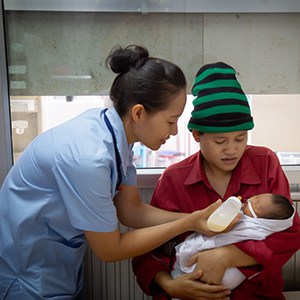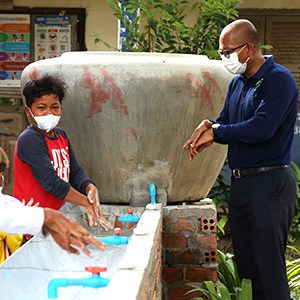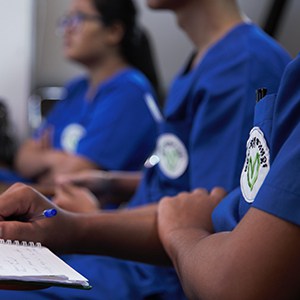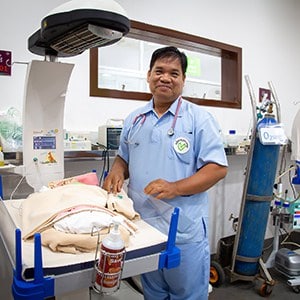Four-year-old Kiri has been visiting AHC since July 2020 to receive retinoblastoma cancer treatment. He and his father Amara have visited the AHC oncology unit and eye clinic every month for surgery and multiple stages of chemotherapy in order to treat his cancer.
Retinoblastoma most commonly affects young children, beginning in the sensitive lining on the inside of the eye. If retinoblastoma tumors are left untreated, they can grow and spread throughout the eye, which is a concern to Cambodia’s most vulnerable children due to the shortage of local paediatric eye and cancer specialists. AHC is the only facility offering paediatric retinoblastoma treatment outside of the capital, Phnom Penh, treating on average 20 retinoblastoma cases every year.
Kiri lives with his family in a small rural village in Kampot Province. His father Amara is a construction worker and his mother tends to the family farm while caring for Kiri and their ten-month-old baby daughter. The family survives on less than $8 per day from Amara’s construction work. However, Amara stated the regularity and security of this income has been impacted by the COVID-19 pandemic, “Currently there are not many jobs available in my village,” said Amara, “It has been a difficult to take care of my sick son while I try to find work further away from home.”
Amara first noticed Kiri had a problem in his right eye when he was two years old. Initially, they went to their local pharmacy to buy medicine. However, after his sore eye began to lose vision they visited the Takeo Eye Hospital, an hour’s drive from their home. After examining Kiri’s symptoms of poor vision, white pupils, and inflammation of the eye, the doctors at the Takeo Eye Hospital advised Amara to bring Kiri to AHC for immediate treatment.
On arrival at AHC, Amara and Kiri visited the AHC Eye Clinic where Dr Khauv Phara, Chief of Eye Clinic, diagnosed Kiri’s retinoblastoma cancer and referred his case to the Oncology Unit for further examination and outline of his treatment plan. Because of the stage of his cancer, Kiri would require surgery to remove his cancerous eye and six months of chemotherapy to treat any remaining cancerous cells in the body.
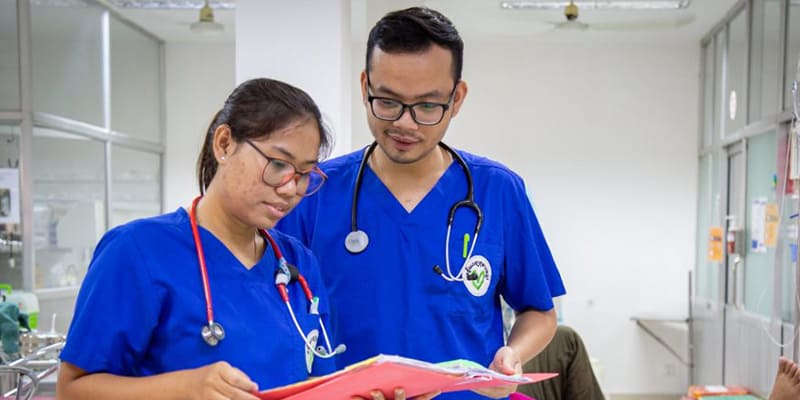
AHC-Oncology-Doctors
Not all retinoblastoma cases require surgery. If the cancer is detected at an early stage then only laser treatment may be necessary, whereas other cases may only need chemotherapy without removing the eye. However, for more severe cases like Kiri, the eye clinic and oncology teams need to work together to successfully treat the case with surgery and chemotherapy. Dr Samly Vannak, AHC oncology specialist doctor, explained the close collaboration between the AHC eye clinic and oncology team, “Every visit Kiri meets with both Dr Phara in the eye clinic and myself, or Dr Sreynich, in the oncology unit,” said Dr Vannak, “We are in constant communication with each other, both when Kiri is in hospital and the weeks in between treatment, to ensure the correct procedures are followed.”
Kiri began two cycles of chemotherapy before his scheduled surgery. AHC implements the VCE Protocol when treating retinoblastoma cases. This involves alternating courses of the chemotherapy drugs vincristine, carboplatin, and etoposide. In the third month of Kiri’s treatment, he underwent surgery, at the hands of Dr Phara, to remove his right eye and the cancerous cells, with an artificial eye put in its place. Tests following surgery revealed the surgery was a success and further surgery would not be needed.
Each month, Kiri and Amara travel to Siem Reap for treatment, staying for at least three days each visit. Amara describes the difficulty of travelling to Siem Reap for Kiri’s treatment during the global pandemic, “We decided it was best for me to accompany my son and my wife to stay at home to care for our youngest daughter,” said Amara, “Kiri and I have travelled to Siem Reap many times now. The trip is long (over 12 hours one way) and expensive ($15 one way) for us.” To help with their travel expenses, the family receives financial assistance from the AHC social work unit.
Kiri’s treatment was not without some complications and challenges. Kiri experienced pain, nausea and hair loss throughout his treatment, and in the third cycle of his treatment, he developed neutropenic fever caused by bone marrow suppression and low white blood cell count, increasing his risk of infection. The doctors began a course of meropenem, a powerful antibiotic, which reduced his fever and stopped any infection spreading.
Kiri is now in his final cycle of chemotherapy treatment with a full recovery expected. Amara is happy to see his son begin to show signs of recovery, “Kiri now runs and plays with other children in the village,” said Amara, “We hope he can continue growing and enjoy his life in the future. Although it is a long way for us to travel, I am happy that Kiri could receive quality oncology care at AHC.”
